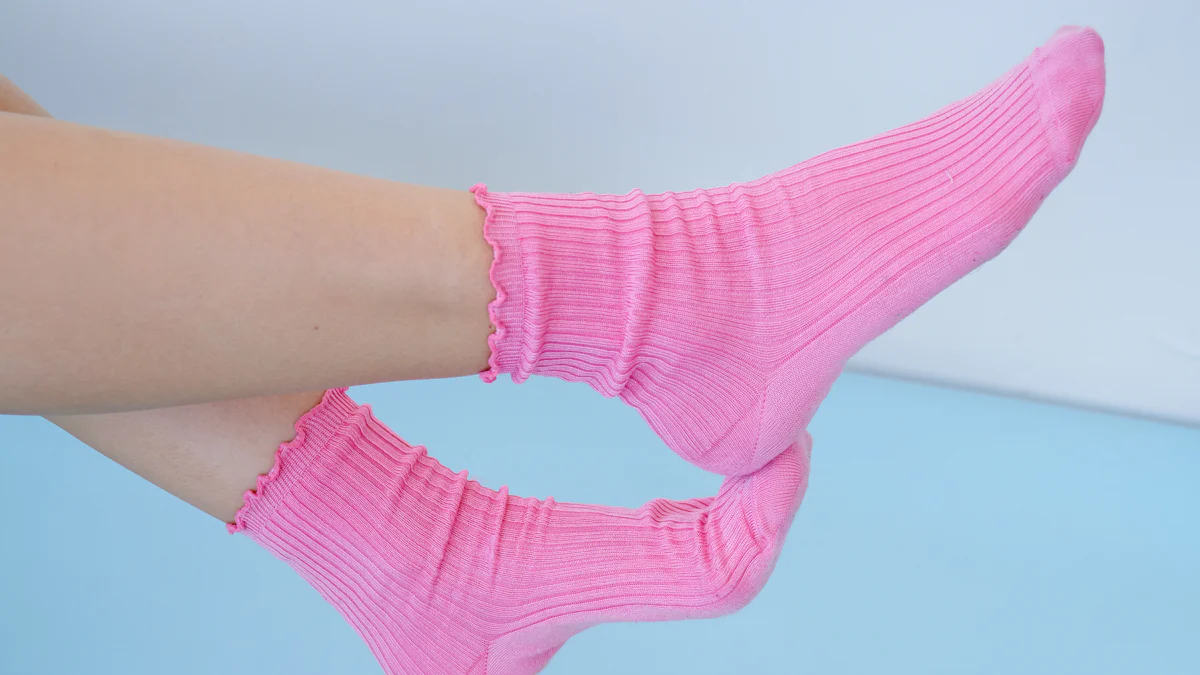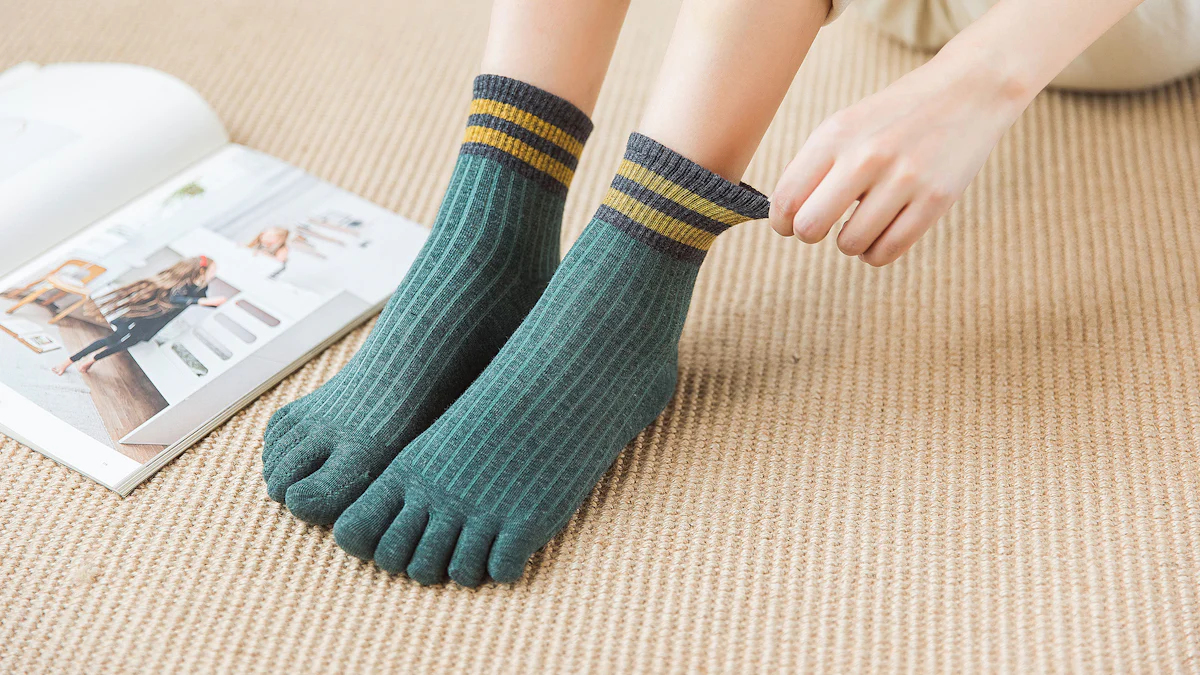
Sensory-friendly clothing is essential for children with autism. Many children with autism experience sensory processing dysfunction, affecting up to 90% of individuals with Autism Spectrum Disorder (ASD). Autism socks for children are a key item in providing comfort and support. This blog aims to guide parents in choosing the best autism sock for children, ensuring daily comfort and improved sensory experiences.
Understanding Sensory Socks

What Are Sensory Socks?
Definition and Purpose
Sensory socks are specialized clothing items designed to provide comfort and support for children with sensory processing disorders. These socks use materials like cotton, bamboo, and spandex to create a soft, seamless fabric. This fabric helps reduce discomfort and irritation. Sensory socks aim to make daily activities more manageable for children who struggle with sensory issues.
How They Differ from Regular Socks
Regular socks often have seams, rough textures, or tight bands that can irritate sensitive feet. Sensory socks eliminate these issues by offering a seamless construction and using soft, breathable fabrics. This design helps prevent the bunching and pressure points that can cause distress for children with sensory sensitivities. Sensory socks also often feature moisture-wicking properties to keep feet dry and comfortable throughout the day.
Importance of Sensory Socks for Children with Autism
Benefits for Sensory Processing
Sensory socks play a crucial role in helping children with autism manage sensory processing challenges. These socks provide consistent, gentle pressure that can help regulate sensory input. This pressure can be calming and can help improve focus and attention. Sensory socks also reduce the likelihood of sensory overload by minimizing irritating stimuli.
Impact on Daily Comfort and Activities
Wearing sensory socks can significantly enhance a child’s daily comfort. The seamless design and soft materials help prevent discomfort and distractions caused by traditional socks. This improvement in comfort can lead to better participation in daily activities, such as playing, learning, and socializing. Sensory socks can make mornings easier for families by reducing the stress associated with getting dressed.
Key Features to Look for in Sensory Socks

Material and Fabric
Softness and Texture
When choosing an autism sock for children, the material plays a crucial role. Soft fabrics like cotton, bamboo, and spandex provide a gentle touch against the skin. These materials help reduce irritation and discomfort, making daily wear more pleasant. The texture of the fabric should feel smooth and non-abrasive. Children with sensory sensitivities often prefer socks that feel soft and cozy.
Breathability and Moisture-Wicking Properties
Breathable fabrics keep feet cool and dry. Materials like bamboo and cotton excel in moisture-wicking properties. These fabrics draw sweat away from the skin, preventing dampness and reducing the risk of fungal infections. Breathable socks ensure that children’s feet remain comfortable throughout the day. This feature is particularly important for active children who may sweat more.
Seamless Design
Importance of Seamless Construction
Seamless construction eliminates the discomfort caused by seams. Traditional socks often have seams that can rub against the skin, causing irritation. A seamless design ensures that the sock fits smoothly against the foot. This feature is essential for children with sensory processing disorders. Seamless socks provide a more comfortable wearing experience.
How Seams Can Affect Sensory Sensitivity
Seams can create pressure points that irritate sensitive feet. Children with autism may find seams particularly bothersome. The constant rubbing can lead to distractions and discomfort. Seamless socks prevent these issues by offering a smooth, even surface. This design helps children focus on their activities without being distracted by uncomfortable sensations.
Compression and Fit
Benefits of Compression for Sensory Regulation
Compression socks provide gentle pressure that can help regulate sensory input. This pressure can have a calming effect on children with autism. Compression socks can improve focus and reduce anxiety. The consistent pressure helps children feel more secure and grounded. This feature makes compression socks a valuable tool for sensory regulation.
Ensuring the Right Fit for Comfort
The right fit is crucial for comfort. Socks that are too tight can cause discomfort and restrict movement. Socks that are too loose can bunch up and create pressure points. Measuring your child’s feet accurately can help you choose the right size. Many brands offer size charts to guide you in selecting the best fit. Properly fitting socks enhance comfort and support.
Practical Tips for Choosing Sensory Socks
Involving Your Child in the Selection Process
Understanding Their Preferences
Involving your child in the selection process can make a significant difference. Children with autism often have specific preferences and sensitivities. Allowing your child to express these preferences can help you choose the best autism sock for children. Some children may prefer certain colors or patterns, while others might focus on the texture or feel of the socks.
Trying Different Options
Trying different options can help you find the perfect fit. Some brands offer trial packs that include various styles and materials. This approach allows your child to experience different sensations and decide which ones feel most comfortable. For example, Wyatt, who reviewed sensory socks, found that trying multiple brands helped identify the most comfortable options. Encouraging your child to wear each pair for a short period can provide valuable feedback on comfort and fit.
Checking for Quality and Durability
Importance of High-Quality Materials
High-quality materials play a crucial role in the effectiveness of sensory socks. Materials like cotton, bamboo, and spandex offer softness and breathability. These fabrics reduce irritation and provide a comfortable wearing experience. Investing in high-quality socks ensures that your child receives the best support and comfort. Kirk M., a parent of a child with a sensory disorder, noted that SmartKnitKIDS socks provided exceptional comfort due to their high-quality construction.
Longevity and Wear Resistance
Durability is another important factor to consider. Sensory socks should withstand daily wear and frequent washing without losing their shape or effectiveness. Look for socks with reinforced toes and heels to ensure longevity. Durable socks save you money in the long run by reducing the need for frequent replacements. Brands known for their durability often provide better value and satisfaction.
Recommended Brands and Products
Top Brands for Sensory Socks
Overview of Popular Brands
Several brands specialize in sensory socks, offering unique features tailored to children with autism. SmartKnitKIDS provides seamless sensitivity socks that eliminate irritating seams. These socks offer a smooth texture, making them ideal for children with sensory processing disorders. CalmCare focuses on using bamboo fabric, which provides a soft and breathable feel. These socks also offer compression, which can help with sensory regulation.
Soothe Step offers a variety of styles and designs, allowing children to choose based on personal preferences. These socks use high-quality materials to ensure comfort and durability. Seamless Smooth Toe Socks are another excellent option. These socks feature a smooth toe seam, providing comfort for sensitive feet. Parents often choose these socks for their effectiveness in reducing discomfort.
Unique Features of Each Brand
SmartKnitKIDS socks stand out for their seamless construction. This design helps prevent irritation and discomfort, making daily wear more pleasant. CalmCare socks use a blend of bamboo, polyester, and elastane. This combination provides a cocoon-like fit, offering both comfort and compression. The seamless feel and lack of a heel make these socks perfect for children with hypersensitivity.
Soothe Step sensory socks come in various patterns and colors. This variety allows children to select socks that match their sensory and aesthetic preferences. These socks also use therapeutic materials, making mornings easier for families. Seamless Smooth Toe Socks focus on providing a smooth toe seam. This feature is crucial for children who find traditional seams bothersome.
Product Recommendations
Specific Models and Their Benefits
- SmartKnitKIDS Seamless Sensitivity Socks
- Benefits: Seamless design, soft texture, high comfort level.
- Ideal For: Children with sensory processing disorders.
- CalmCare 3 Pack of Sensory Socks
- Benefits: Bamboo fabric, compression, seamless feel, no heel.
- Ideal For: Children with hypersensitivity or sensory processing disorder.
- Soothe Step Sensory Friendly Socks
- Benefits: Variety of styles, high-quality materials, therapeutic benefits.
- Ideal For: Children with autism and ADHD.
- Seamless Smooth Toe Socks
- Benefits: Smooth toe seam, comfortable for sensitive feet.
- Ideal For: Children with sensory issues.
- Body Socks
- Benefits: Calming effect, reduces sensory overload, versatile use.
- Ideal For: Quiet time or story time.
Where to Purchase
You can purchase SmartKnitKIDS socks from their official website or major online retailers like Amazon. CalmCare socks are available on their website and select specialty stores. Soothe Step sensory socks can be found on their website and various online marketplaces. Seamless Smooth Toe Socks are available through their official site and popular e-commerce platforms. Body Socks can be purchased from sensory equipment stores and online retailers specializing in therapeutic products.
Choosing the right sensory socks for children with autism holds significant importance. Sensory socks can greatly enhance comfort and daily activities. Parents should always consider the child’s unique needs and preferences. Involving the child in the selection process can lead to better outcomes.
“Oh my gosh!!! This made my day, week, maybe even year!! Thank you so so much. My daughter has Sensory Processing Issues and socks are our biggest hurdle!!!” — Parent
Final tips include focusing on high-quality materials, seamless designs, and proper fit. Making an informed decision ensures that sensory socks provide the best support and comfort for your child.

